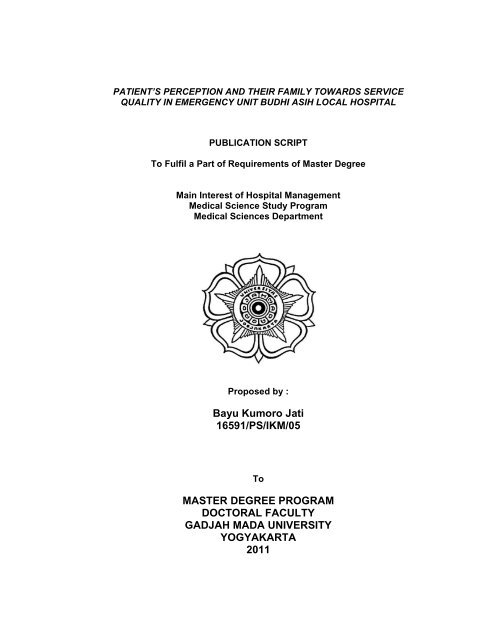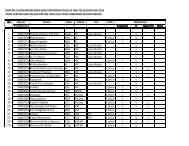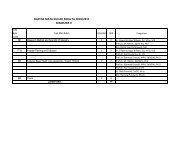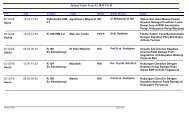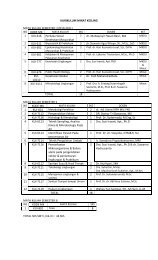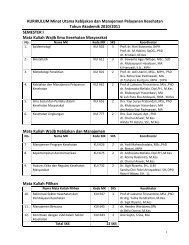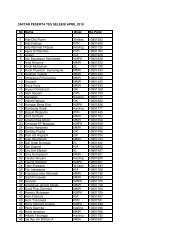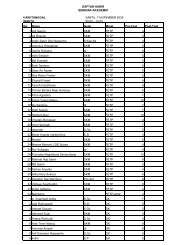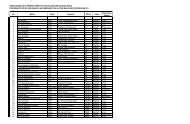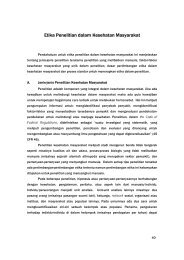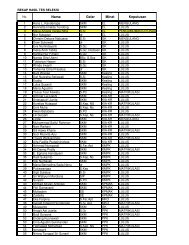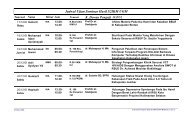Bayu Kumoro Jati 16591/PS/IKM/05 MASTER DEGREE PROGRAM ...
Bayu Kumoro Jati 16591/PS/IKM/05 MASTER DEGREE PROGRAM ...
Bayu Kumoro Jati 16591/PS/IKM/05 MASTER DEGREE PROGRAM ...
Create successful ePaper yourself
Turn your PDF publications into a flip-book with our unique Google optimized e-Paper software.
PATIENT’S PERCEPTION AND THEIR FAMILY TOWARDS SERVICE<br />
QUALITY IN EMERGENCY UNIT BUDHI ASIH LOCAL HOSPITAL<br />
PUBLICATION SCRIPT<br />
To Fulfil a Part of Requirements of Master Degree<br />
Main Interest of Hospital Management<br />
Medical Science Study Program<br />
Medical Sciences Department<br />
Proposed by :<br />
<strong>Bayu</strong> <strong>Kumoro</strong> <strong>Jati</strong><br />
<strong>16591</strong>/<strong>PS</strong>/<strong>IKM</strong>/<strong>05</strong><br />
To<br />
<strong>MASTER</strong> <strong>DEGREE</strong> <strong>PROGRAM</strong><br />
DOCTORAL FACULTY<br />
GADJAH MADA UNIVERSITY<br />
YOGYAKARTA<br />
2011
1<br />
PATIENT’S PERCEPTION AND THEIR FAMILY TOWARDS SERVICE<br />
QUALITY IN EMERGENCY UNIT BUDHI ASIH LOCAL HOSPITAL<br />
<strong>Bayu</strong> <strong>Kumoro</strong> <strong>Jati</strong> 1 , Agastya 2<br />
ABTRACT<br />
Backgrounds: Budhi Asih Local Hospital is one of the regional public<br />
hospital in DKI Jakarta Province, type B hospital with 254 bed capacity,<br />
serve health care for East Jakarta Population and surroundings. 80 %<br />
inpatient comes from Emergency Unit Budhi Asih Local Hospital.<br />
Acknowledge for providing health care services among poor people.<br />
Through box suggestion and mass media there are complaints regarding<br />
patient’s dissatisfaction. There has been no research in Budhi Asih Local<br />
Hospital regarding the patient complaints.<br />
Objectives: The purpose of this study is to analyze patient’s perception<br />
level in order to give input for health care policy to preserve services<br />
quality in Emergency Unit Budhi Asih Local Hospital.<br />
Methods: This is a descriptive study with cross sectional prospective<br />
design. Questionnaires which were used as measuring instruments were<br />
adopted from SERVQUAL instruments (Parasuraman et al, 1988).The<br />
health care services perception will be better if patient’s satisfaction levels<br />
are higher.<br />
Results: Overall patient’s perception and their family towards quality<br />
services in Emergency Unit Budhi Asih Local Hospital is satisfying enough<br />
with score 4,944 or 82,33%. Even though there is an aspect of<br />
SERVQUAL dimension with the lowest score which is responsiveness<br />
dimension: quick responds toward services to costumer. GAKIN status<br />
patient has the highest score in all SERVQUAL dimension (112,74).<br />
Conclusions: Management policy regarding to service quality in Budhi<br />
Asih Local Hospital was satisfying enough. Maintenance and monitoring<br />
policy of services quality should develop continuously, in order to have an<br />
optimal standard of health care services.<br />
Keywords: Budhi Asih Local Hospital, patient’s satisfaction, service<br />
quality, patient’s perception.<br />
1. Functional staff of Emergency Unit Budhi Asih Local Hospital<br />
2. SE, MBA, MPM, Faculty of Public Health, Gadjah Mada University,<br />
Yogyakarta
2<br />
INTRODUCTION<br />
Budhi Asih Regional General Hospital is a type B non-educational<br />
Regional General Hospital established by the Decree of the Minister of<br />
Health of the Republic of Indonesia No. 434/Menkes/SK/IV/2007 April 10,<br />
2007 and a Technical Implementation Unit of DKI Jakarta Health Agency.<br />
Currently Budhi Asih Regional General Hospital has a capacity of 254<br />
beds that provide various types of medical services consisting of the<br />
Emergency Unit, which opened 24 hours continuously, specialists and<br />
sub-specialists. Medical support services includes the Clinical Laboratory,<br />
Radiology, Electro-medical, Operating Room, Pharmacy and Corpse<br />
Conservation, all of it are ready to serve 24 hours.<br />
Target of the Budhi Asih Hospital Services are to serve the people<br />
of East Jakarta and surrounding areas, as a referral center for the area of<br />
East Jakarta, and to carries out social mission as a service center for<br />
patient of Poor Families (GAKIN) and GEPENG (vagrant and panhandler).<br />
In accordance with these targets, Budhi Asih Regional General Hospital<br />
serves a variety of walks of life, the average is from lower class to middle,<br />
from low to high levels of education, so that the plurality provides its own<br />
difficulties in serving the community as a customer.<br />
Of all patients who check into Budhi Asih Regional General<br />
Hospital, according to Budhi Asih Hospital Yearbook 2008, the Emergency<br />
Unit (UGD) contributes a lot to the hospital because 80% of inpatients are<br />
coming from the emergency unit. It is because this unit are open 24 hours<br />
and automatically serve the patient after all polyclinic closed at noon. As<br />
the spearhead and the frontline of hospital services, the services<br />
contained in the emergency unit will reflect the image of service in the<br />
Budhi Asih Hospital. Therefore, management in emergency unit requires<br />
the handling is good and should get special attention from management of<br />
Budhi Asih Hospital.<br />
In practice, service of emergency unit in Budhi Asih Hospital<br />
performed by medical and paramedical personnel with the basic
3<br />
knowledge and skills of nursing as well as trained medical knowledge, still<br />
found a lot of complaints from customers. In accordance with the<br />
standards of Emergency Unit, all emergency service personnel of Budhi<br />
Asih Hospital have been specially trained to handle emergency cases.<br />
However there is still dissatisfaction with the Emergency Unit service in a<br />
suggestion box, the writings in both print and electronic media to the<br />
service and performance of the Emergency Unit of Budhi Asih Hospital.<br />
This dissatisfaction is not in accordance with the vision, mission and goals<br />
of Budhi Asih Hospital that is capable of providing excellent service to the<br />
people who come to the Emergency Unit of Budhi Asih Hospital.<br />
Based on research background that has been described above, it<br />
can be concluded that image of Regional General Hospital Budhi Asih<br />
would be good if the patients who come to the Emergency Unit of the<br />
Regional General Hospital Budhi Asih can be served as well, correct and<br />
satisfactory.<br />
RESEARCH METHODOLOGY<br />
This study used design study of cross-sectional prospective study in<br />
the Emergency Unit of Budhi Asih Hospital in East Jakarta to patients or<br />
families who accompany, visit and treatment, with the following provisions:<br />
1. Patient is alive and has a good awareness.<br />
2. Patients are cooperative<br />
3. If the patient is unconscious or uncooperative, then<br />
the family who accompany may substitute as a<br />
respondent.<br />
4. Patients or their families came to the Emergency Unit<br />
of Budhi Asih Hospital since the beginning, not to<br />
other units or are being treated at this hospital.<br />
This study aims to determine the relationship between perceptions<br />
of patients or their families seeking treatment in the emergency unit of<br />
Budhi Asih Hospital with an acceptable quality of service and patient
4<br />
satisfaction. Therefore it was used variables that consist of independent<br />
and dependent variables. The dependent variable is level of satisfaction of<br />
patients or families who accompany. As for the independent variable is a<br />
factor / SERVQUAL Model attribute, those are: physical evidence (the<br />
state or existing facilities) consists of four questions, reliability consists of 5<br />
questions, responsiveness of officers consists of 4 questions, warranty of<br />
service capabilities consist of 4 questions, and empathetic of care workers<br />
consists of 5 questions.<br />
The subjects in this study are respondents data, i.e. data<br />
questionnaire that has been filled by patients or families who accompany,<br />
they are who come for treatment in the Emergency Unit of Budhi Asih<br />
Hospital. While the objects in this study is result of assessment of quality<br />
service that has been processed by instrument of SERVQUAL Model.<br />
Population used in this study were all patients who come for<br />
treatment to the Emergency Unit of the Budhi Asih Hospital, East Jakarta,<br />
who was aged adults (older or equal to 17 years) so as to be able to fill out<br />
questionnaires, cooperative and well-consciousness (not fainting, shock or<br />
coma).<br />
Inclusion Criteria:<br />
1. Patients or families of patients who were treated in the<br />
Emergency Unit of Budhi Asih Hospital<br />
2. Respondents know, understand and cooperative on<br />
the question and fill out a questionnaire of the study<br />
3. General condition of the patients or their family makes<br />
it possible to perform filling out a questionnaire<br />
4. Willing to follow the research and fill out<br />
questionnaires<br />
Exclusion Criteria:<br />
1. Rather than patients or families of patients who were<br />
treated in the Emergency Unit of Budhi Asih Hospital
5<br />
2. Respondents did not cooperate because of pain or<br />
loss of consciousness and the patient's family did not<br />
cooperate because of panicky<br />
3. Illiterate<br />
4. Not willing to follow the research and neither to fill out<br />
questionnaires<br />
This research was conducted by using a questionnaire on these<br />
variables, translating variables in terms of assessment instruments and<br />
appropriate questions according to the assessment instrument of<br />
SERVQUAL Model. The research was conducted at the Emergency Unit<br />
of Budhi Asih Hospital, East Jakarta, Jl. Dewi Sartika during the month of<br />
September 2010. The research team has been formed by involving of all<br />
nurses in the emergency room.<br />
The next stage is perform approach and coordination to the<br />
management party of Budhi Asih Hospital with a research permit, to make<br />
this research as it should have permission, even integrated with quality<br />
improvement programs of Budhi Asih Hospital.<br />
Dividing questionnaire conducted by research staff who are<br />
previously briefed beforehand about the purpose of research, how to fill<br />
the data and its implementation plans.<br />
The data has been collected will be analyzed by statistical methods<br />
with test analysis of one-way different variants of F test (One Way<br />
ANOVA) which is an analysis to determine differences of service quality<br />
variables that are perceived and satisfaction of patients or families who<br />
accompany them. Post-ANOVA test is to determine items differences of<br />
inter-status dimensional quality of patient, and T-test is to determine<br />
perception differences in the service quality among patients with health<br />
insurances (ASKES), patients with social department insurances<br />
(DINSOS), patients of poor families (GAKIN), and general patients.<br />
RESEARCH RESULTS
6<br />
1. Characteristics of Respondents<br />
This study was used a questionnaire to obtain data from 80<br />
research subjects. Research subjects are patients or their families who<br />
visit the Emergency Unit of Budhi Asih Hospital. The data contained<br />
description of the characteristics of research subjects based on patient<br />
status.<br />
Table 1:<br />
Status Patient Characteristics Based on Visitation to the Emergency<br />
Unit of Budhi Asih Hospital<br />
Number Patient Frequency Percentage (%)<br />
1.<br />
2.<br />
3.<br />
4.<br />
ASKES<br />
DINSOS<br />
GAKIN<br />
General<br />
1<br />
1<br />
47<br />
31<br />
1.3<br />
1.3<br />
58.8<br />
38.8<br />
TOTAL 80 100<br />
Number of patient ASKES is only 1 person or 1.3% of all research<br />
subjects, as well as the number of patients DINSOS. Number of patients<br />
GAKIN is 47 people or 58.8% which is the majority of research subjects.<br />
And number of General patients is 31 people or 38.8% of all research<br />
subjects.<br />
2. Patient Perceptions on Quality of Service<br />
Table 2:<br />
Perceptions on Service Quality of Emergency Unit of Budhi Asih<br />
Hospital<br />
Number Dimension Average values<br />
1.<br />
2.<br />
3.<br />
4.<br />
5.<br />
Physical Evidence<br />
Reliability<br />
Responsiveness<br />
Assurance<br />
Empathy<br />
4.92<br />
4.90<br />
4.89<br />
5:00<br />
5:01<br />
Average 4944<br />
Patient's or their family's assessment to Emergency Unit of Budhi<br />
Asih Hospital service is in an average total of 4.944 or 82.33% of the Likert<br />
scale with range 1-6. Based on the Likert scale it is known that the
7<br />
average of patient's perception on the service quality is 4.94 is in the<br />
range rather agree to agree. The highest value found in the empathy<br />
dimension of 5.01, while the lowest value found in the dimension of<br />
responsiveness of 4.89. Patient's perceptions on the empathy include: (a)<br />
Emergency Unit of Budhi Asih Hospital gives special attention to patients<br />
and their families and there is a suggestion box, (b) doctors and nurses<br />
give special attention (personal) over complaints of disease, (c) doctors<br />
and nurses understand the needs of patients and their family, (d)<br />
Emergency Unit of Budhi Asih earnest attention to the interests and<br />
complaints of patients and their families, (e) Time of service in accordance<br />
with the wishes of patients and their families.<br />
3. Analysis of the patient's perception on the service quality<br />
of each patient's status<br />
Patient's assessment on service quality in the Emergency Unit of<br />
Budhi Asih on the dimensions of physical evidence was viewed per item.<br />
Item of modern equipment was ranked lowest by number 366 with an<br />
average of 91.5. Facilities which are visual appeal have ranked the highest<br />
with number 407 with an average of 101.75.<br />
Patient's assessment on service quality in the Emergency Unit of<br />
Budhi Asih on the dimensions of reliability is the highest that is equal to<br />
411 with an average of 102.75 because it is open 24 hours and serve on<br />
time. Item of time is promised to wait and get the services are kept in<br />
accordance with the promise is the lowest that is 368 with an average of<br />
92.<br />
The highest patient's assessment on service quality in the<br />
Emergency Unit of Budhi Asih on the dimensions of responsiveness is in<br />
the item number 2 in which patients served immediately in the Emergency<br />
Unit of Budhi Asih that is 402 with an average of 100.5. While the lowest<br />
item is Emergency Unit of Budhi Asih informs exactly what time patient will<br />
receives a service that is 371 with an average of 92.75.
8<br />
Patient's assessment on service quality in the Emergency Unit of<br />
Budhi Asih on the dimensions of guarantees, the highest is in the item<br />
both doctors and nurses are courteous in serving patients that is 410 with<br />
an average of 102.5. While the lowest item is both doctors and nurses<br />
seem to have the full support of the hospital leader that is 387 with an<br />
average of 96.75.<br />
Patient's assessment on service quality in the Emergency Unit of<br />
Budhi Asih in the dimensions of empathy, the highest is in the item it is<br />
open 24 hours and the time of service is in accordance with the wishes of<br />
patients that is 407 with an average of 101.75. While the item of doctors<br />
and nurses understand the needs of patients is the lowest that is 392 with<br />
an average of 98.<br />
4. Analysis of Patient's Perceptions on Service Quality to the<br />
Patient of ASKES, DINSOS, GAKIN, and General Patient<br />
The purposes of analysis are to compare the quality of care<br />
received by patients, among patients with health insurance (ASKES),<br />
patients with social department insurance (DINSOS), patients from poor<br />
families (GAKIN), and public patients.<br />
Table 3:<br />
Perceptions Differences in Service Quality to Patients of ASKES,<br />
DINSOS, GAKIN, and Public<br />
Dimension ASKES DINSOS GAKIN Public<br />
Physical Evidence 10 17 979 567<br />
Reliability 21 25 1196 717<br />
Responsiveness 21 20 949 575<br />
Assurance 15 20 960 6<strong>05</strong><br />
Empathy 26 25 1215 738<br />
Total Score 93 107 5299 3202<br />
The average score on the 93 107 112.74 103.29<br />
number of respondents<br />
There are differences between patients with health insurance<br />
(ASKES), patients with social department insurance (DINSOS), patients of<br />
poor families (GAKIN) and general patients in all dimensions. The results
9<br />
of the mean score obtained that GAKIN patients have a higher perception<br />
value of the service quality compared to the status of the other patients in<br />
all dimensions of SERVQUAL that is 112.74.<br />
DISCUSSION<br />
1. Characteristics of Respondents<br />
Respondents in this study consisted of patients or families of<br />
patients who were treated in Emergency Unit of Budhi Asih Regional<br />
General Hospital. Emergency Nurses Association (20<strong>05</strong>) stated that the<br />
main customers of the Emergency Unit in a hospital are the patients and<br />
their family. The largest number of respondents in this study is come from<br />
the status of GAKIN patients (58.8%). This is due to Budhi Asih Hospital is<br />
a referral center for East Jakarta GAKIN. Since the beginning of the<br />
hospital founding, ranging from "Taman Harapan", the Polyclinic of<br />
Unemployment Home which has the mission of providing social services in<br />
the areas of health care for displaced (poor) patients, especially for the<br />
homeless drifter and panhandler (GEPENG) until it is formalized and<br />
administered by health department of DKI Jakarta, Budhi Asih Hospital<br />
serves patients with GAKIN status. And this is has long been known to the<br />
surrounding community.<br />
2. Patient's Perceptions on Service Quality<br />
The average of patient's perception on the service quality in all four<br />
groups of patients namely patients of ASKES, DINSOS, GAKIN, and<br />
general patients are 4.94 in the Likert scale. This score is between rather<br />
agree and agree. This may imply that the service provided by the Budhi<br />
Asih General Hospital is good enough according to the patient's<br />
perception that is 82.33%. This may be caused by management that<br />
responds to increase quality of hospital services. Budhi Asih Hospital<br />
evaluates the quality of health care through patient questionnaires and<br />
morning report that is held every day.
10<br />
The highest element of quality dimension is the dimension of<br />
empathy, followed by guarantee dimension. Empathy dimension includes,<br />
among others, give individual attention to customers, employees treat<br />
customers fully attention, earnestly give priority to the interest of<br />
customers, employees understand customer's needs, and operating time<br />
(hours) is comfortable. While the dimensions of assurance includes<br />
employees who foster a sense of trust to customers, making customers<br />
feel safe while doing the transaction, employees who are consistently<br />
courteous, and employees are able to answer customer's questions.<br />
The lowest element of the quality dimension is responsiveness. The<br />
dimensions of responsiveness include, among others, inform the<br />
customers about the certainty of service applying time, prompt service for<br />
customers, willingness to help customers, and readiness to respond to<br />
customer requests. The lowest element of this dimension is Emergency<br />
Unit of Budhi Asih informs exactly what time the patient will receive<br />
services. This is probably caused by the scale of priority (triage) on the<br />
handling of patients in the Emergency Unit of Budhi Asih and the big<br />
number of patients due to Budhi Asih Hospital is a referral hospital in East<br />
Jakarta and surrounding areas. In addition, the lack of medical personnel<br />
to serve the quota of patients in which sometimes is in great quantities at<br />
certain times.<br />
Currently the quality of health services must be attended. Because<br />
it is ordered in Law no. 44 Year 2009 on the Hospital, as contained in<br />
article 29 paragraph 1 point (b), each hospital has an obligation to provide<br />
health care safety, quality, antidiscrimination, and effectively by priority the<br />
interests of patients according to standard hospital care.<br />
3. Patient's Perceptions on Service Quality to the Patients of<br />
ASKES, DINSOS, GAKIN, and General<br />
Based on the research results there are differences in perceptions<br />
of quality of care among patients of ASKES, DINSOS, GAKIN, and
11<br />
general in all dimensions of quality of service that is physical evidence,<br />
reliability, responsiveness, assurance, empathy, and the dimensions of<br />
quality. Health care insurances for poor families (GAKIN) is a assurance of<br />
health care provided to poor families and families who need health<br />
services include outpatient and inpatient, as defined, both in the public<br />
health center or a designated hospital in DKI Jakarta area. Patients of<br />
social department referral are patients who include destitute, homeless,<br />
panhandler and the inhabitants of the social institute under social<br />
department of Jakarta are all referred by a covering letter from the Sub<br />
Social Department, Social Department of DKI Jakarta and the Department<br />
of Social Jakarta, all of which must be served free of charge in accordance<br />
with the agreement between the Social Ministry and Local Government of<br />
DKI Jakarta.<br />
It is obtained that score of GAKIN patients is higher than other<br />
patients. It is imply that GAKIN patients feeler the service provided by<br />
emergency unit of Budhi Asih Regional General Hospital. This is in<br />
accordance with the daily reality in which there are many grievances or<br />
complaints from other patients, particularly public patients. This is the<br />
result of a very necessary concern for all parties to be able to provide<br />
optimum services for all groups of patients adjust to the expectations of<br />
groups that deliver most of the complaints.<br />
This is understandable because GAKIN patients who come from<br />
poor families are more accepting of the situation and feel better with the<br />
facilities provided by the hospital because there is not much demand in<br />
accordance with their existence in the environment.<br />
CONCLUSIONS AND SUGGESTION<br />
Based on the results of research and discussion that have been<br />
raised in the previous chapter, the conclusion can be drawn as follows:
12<br />
1. There is accurate data / information on the patient's<br />
perception and their families to service quality in the<br />
Emergency Unit of Budhi Asih General Hospital<br />
2. There are differences in identification of key dimensions and<br />
aspects within each dimension that requires quality<br />
improvement<br />
3. There are differences in expectations and the quality of care<br />
received by customers<br />
4. There is a relationship between SERVQUAL dimensions to<br />
the level of patient satisfaction.<br />
5. Reliability significantly influences the level of patient<br />
satisfaction in the Emergency Unit of Budhi Asih Hospital.<br />
6. Responsiveness significantly influences the level of patient<br />
satisfaction in the Emergency Unit of Budhi Asih Hospital.<br />
7. Assurance is significantly influence on the level of patient<br />
satisfaction in the Emergency Unit of Budhi Asih Hospital.<br />
8. Empathy is significantly influence the level of patient<br />
satisfaction in the Emergency Unit of Budhi Asih Hospital.<br />
9. Physical evidence is significantly influences on the level of<br />
patient satisfaction in the Emergency Unit of Budhi Asih<br />
Hospital.<br />
The advice can be given:<br />
1. Management of the hospital set a new policy regarding the<br />
services that is refer to patient satisfaction and disseminated<br />
to all doctors, nurses, and all parties involved in services<br />
2. The management of the hospital continuously monitor the<br />
quality of service either by filling out a checklist for each<br />
patient's home that is attached on the status or by<br />
conducting interviews
13<br />
3. For uniformity of service management need to standardize<br />
the service performance process and doing a good training<br />
of personnel<br />
4. Encourage motivation to staff to improve service quality<br />
through policies that can support quality of service.<br />
5. Make similar studies in both Inpatient and Outpatient Unit so<br />
as to the hospital has data service quality as a whole.<br />
REFERENCES<br />
1. Azwar, A. 1996. Menjaga Mutu Pelayanan Kesehatan, Pustaka Sinar<br />
Harapan, Jakarta.<br />
2. Basrana, M. 2010. Kualitas Pelayanan Rawat Inap di Rumah Sakit<br />
Umum Daerah Teluk Kuantan. Tesis. Program Pascasarjana Fakultas<br />
Kedokteran Universitas Gadjah Mada Yogyakarta.<br />
3. Boerstler, H. 1996. Implementation of Total Quality<br />
Management:Conventional Wisdom versus Reality, Hospital and Health<br />
Services Administration, 41:2<br />
4. Departemen Kesehatan RI, 1992a. Pedoman Pelayanan Gawat<br />
Darurat, Direktorat Rumah Sakit Khusus dan Swasta, Direktorat<br />
Jenderal Pelayanan Medik.<br />
5. Departemen Kesehatan RI, 1992b. Standar Pelayanan Rumah Sakit,<br />
Direktorat Rumah Sakit Umum dan Pendidikan, Direktorat Jenderal<br />
Pelayanan Medik.<br />
6. Donabedian, A., 1988. The Quality of Care, How can it be assessed<br />
?Journal of The American Medical Association. (12), 260, pp.1743-<br />
1748.<br />
7. Emergency Nurses Association. 20<strong>05</strong>. Costumer Service and<br />
Satisfaction in the Emergency Department. Top Emerg Med (27), 4, pp<br />
327-328.<br />
8. Gitlow, H.S.. Gitlow, S.J. 1994. Total Quality Management in Action:<br />
Combines Deming’s Philosophy and Japanese Management Systems,<br />
PTR Prentice Hall, Englewood Cliffs Inc, New Jersey.<br />
9. Hadisudarmo, S., 1998. Peningkatan Mutu Pelayanan Tindakan Bedah<br />
Darurat melalui Sosialisasi Pendekatan Manajemen Mutu Terpadu<br />
RSSUD Budhi Asih, Jakarta. Tesis UGM.<br />
10. Hegdes, J.R., Trout A., Magnusson A.R. 2002. Satisfied Patients<br />
Exiting the Emergency Department (SPEED) Study. Academic<br />
Emergency Medicine (9), 1, pp 15-22.<br />
11. Jacobalis. 1990. Kegiatan Pemasaran Rumah Sakit, Seminar<br />
Pemasaran dan Kebijakan Promosi Rumah Sakit. IRSJAM. Majalah<br />
Perumahsakitan edisi XVIII Apriil-Juni. Jakarta.
12. Lam, S.S.K., 1995. Quality Management and Job Satisfaction,<br />
International Journal of Quality and Reliability Management, v12n4, pp<br />
72-78.<br />
13. Parasuraman, A., Zeithaml, V.A., and Berry, l.l., 1988, SERVQUAL; A<br />
Multiple Item Scale for Measuring Consumer Perceptions of Service<br />
Quality, Journal of Retailing, Spring 1988, 64, 1:12-40<br />
14. Suryadi, Y. 1998. Hubungan Antara Persepsi tentang Mutu Pelayanan<br />
dan Kepuasan Pasien atau Pengantarnya di Unit Gawat Darurat RSUD<br />
Kabupaten Ponorogo. Tesis. Program Pasca Sarjana Universitas Gajah<br />
Mada Yogyakarta.<br />
15. Tjiptono, F., Chandra, G., 20<strong>05</strong>. Service, Quality & Satisfaction.<br />
Yogyakarta. ANDI.<br />
16. Wijono, D. 2000. Manajemen Mutu Pelayanan Kesehatan. Teori,<br />
Strategi, dan Aplikasi. Vol. 1. Airlangga University Press. Surabaya<br />
17. Yuliani. 2007. Kualitas Pelayanan Rawat Jalan di Rumah Sakit Restu<br />
Ibu Balikpapan. Tesis UGM. Yogyakarta.<br />
14


